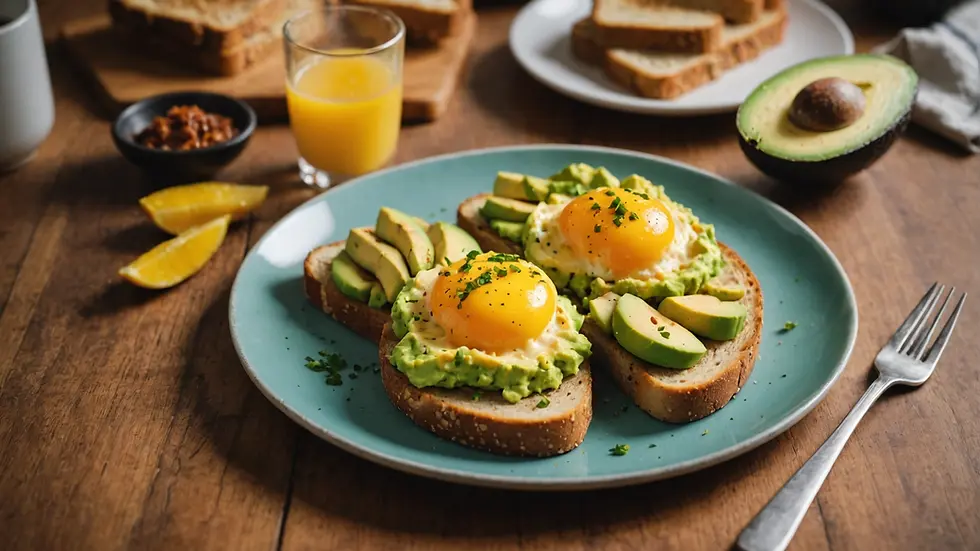Would You Like to See a Practical Example of Balanced Eating? Check Out This Day's Menu and Caloric Breakdown!
- S.L.Wofford
- Nov 7, 2024
- 3 min read
Eating well can feel hard, especially when you're trying to manage calorie intake while getting the right nutrients. Whether your goal is to lose weight, maintain a healthy lifestyle, or nourish your body better, knowing how to structure your meals is key.
In this post, we’ll explore a practical example of a balanced day's eating based on a 1,500-calorie goal. We'll break down each meal, show how it contributes to total calories and nutrients, and provide tips for maintaining balance.
Breakfast: Kick Starting Your Day Right
Let's start with breakfast, often called the most important meal of the day.
2 Scrambled Eggs: 140 calories, 12g protein, 10g fat, 2g carbs
1 Slice of Whole-Grain Toast: 80 calories, 3g protein, 1g fat, 15g carbs
1/2 Avocado: 120 calories, 2g protein, 11g fat, 6g carbs
Breakfast fuels your morning and sets the tone for your eating habits. The combination of eggs, toast, and avocado provides a solid mix of protein, healthy fats, and fiber.

Total for Breakfast: 340 calories, 17g protein, 22g fat, 23g carbs.
Starting your day with a protein-rich breakfast can keep you full longer, reducing the risk of unhealthy snacking.
Lunch: Keeping Your Energy Up
Next, it’s time for lunch! This can be your favorite meal or a quick option.
Grilled Chicken Breast (150g): 220 calories, 42g protein, 5g fat, 0g carbs
Quinoa (1/2 cup cooked): 110 calories, 4g protein, 2g fat, 19g carbs
Steamed Broccoli (1 cup): 50 calories, 4g protein, 0g fat, 10g carbs
Lunch allows for creativity and is perfect for incorporating lean meats, whole grains, and vegetables. Grilled chicken provides a significant protein boost, important for muscle recovery and overall well-being.

Total for Lunch: 380 calories, 50g protein, 7g fat, 29g carbs.
This meal stands out with high protein and diverse nutrients from the veggies and grains. Studies show that meals high in protein can reduce hunger by 15% more than carb-heavy meals.
Snack: A Midday Boost
Afternoon slumps are common, and snacks can help!
Greek Yogurt (plain, 1 cup): 100 calories, 10g protein, 0g fat, 15g carbs
Almonds (1 oz): 160 calories, 6g protein, 14g fat, 6g carbs
Snacks are vital for bridging gaps between meals without indulgence. Greek yogurt is a fantastic protein source and satisfies creamy cravings, while almonds provide healthy fats that keep energy levels steady.

Total for Snack: 260 calories, 16g protein, 14g fat, 21g carbs.
This snack not only nourishes but also helps maintain stable blood sugar levels, giving you a slow release of energy until dinner.
Dinner: Wrapping Up the Day
Now, let’s explore dinner, a meal that can be both enjoyable and satisfying.
Baked Salmon (150g): 280 calories, 40g protein, 15g fat, 0g carbs
Baked Sweet Potato (100g): 90 calories, 2g protein, 0g fat, 21g carbs
Mixed Greens Salad:
- (lettuce, cucumber, tomato) with olive oil and vinegar dressing: 80 calories, 0g protein, 7g fat, 5g carbs
Dinner is an excellent chance to enjoy your favorite foods while keeping nutrition in mind. Baked salmon is rich in protein and omega-3 fatty acids, crucial for heart health.

Total for Dinner: 450 calories, 42g protein, 22g fat, 26g carbs.
This meal solidifies your daily protein intake without exceeding your calorie target.
Overall Daily Totals
Let’s summarize the totals for the day:
Calories: 1,530
Protein: 123g (32%)
Fats: 60g (35%)
Carbs: 144g (33%)
This breakdown shows that it is entirely possible to follow a balanced eating plan without feeling deprived. The key is ensuring each meal contains a variety of nutrients that your body needs.
Key Takeaways for Balanced Eating
Prioritize Protein: Including protein-rich foods helps with satiety and muscle recovery. Incorporate lean meats, legumes, and dairy into your meals.
Incorporate Healthy Fats: Foods like avocados, nuts, and olive oil may be calorie-dense but are essential for bodily functions.
Choose Complex Carbs: Select whole grains, fruits, and vegetables for sustained energy instead of refined carbs.
Stay Hydrated: Drinking water throughout the day is crucial. It’s easy to mistake thirst for hunger.
Listen to Your Body: Everyone's nutritional needs can differ. It’s important to be mindful of what your body desires.
Final Thoughts: A Sustainable Approach to Eating
Eating is a personal journey, and discovering what works best for you is crucial. This practical example of balanced meals demonstrates that achieving a 1,500-calorie goal is not only feasible but can also be enjoyable.
As you strive toward your health goals, remember that balance and sustainability are more important than strict dieting rules. It is about nourishing your body in a way you can maintain over time.
By incorporating a variety of foods and being mindful of macronutrient ratios, you can find success without guilt.
So why not give this balanced eating approach a try? Your body will appreciate it!


